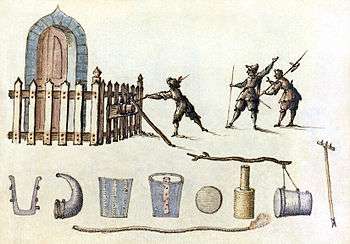Petard
A petard is a small bomb used for blowing up gates and walls when breaching fortifications. It is of French origin and dates back to the 16th century.[1] A typical petard was a conical or rectangular metal device containing 2–3 kg (5 or 6 pounds) of gunpowder, with a slow match for a fuse.


Etymology
Pétard comes from the Middle French péter, to break wind, from the root pet, expulsion of intestinal gas, derived from the Latin peditus, past participle of pedere, to break wind. In modern French, a pétard is a firecracker (and it is the basis for the word for firecracker in several other European languages).
Pétardiers were deployed during sieges of castles or fortified cities. The pétard, a rather primitive and exceedingly dangerous explosive device, comprised a brass or iron bell-shaped device filled with gunpowder and affixed to a wooden base called a madrier. This was attached to a wall or gate using hooks and rings, the fuse lit and, if successful, the resulting explosive force, concentrated at the target point, would blow a hole in the obstruction, allowing assault troops to enter.
Shakespeare's phrase, "hoist with his own petard", is an idiom that means "to be harmed by one's own plan to harm someone else" or "to fall into one's own trap", implying that one could be lifted (blown) upward by one's own bomb, or in other words, be foiled by one's own plan.
Overview
Petards were often placed either inside tunnels under walls, or directly upon gates. The petard's shape allowed the concussive pressure of the blast to be applied entirely towards the destruction of the target structure. Depending on design, a petard could be secured by propping it against the wall or gate using beams, as illustrated, or nailing it in place on a madrier (a thick wooden board fixed in advance to the end of the petard).[2]
Variants

In military use, a petard mortar was a spigot mortar (a weapon that fires explosive projectiles, known as [mortar] bombs, at low velocities, short ranges and parabolic ballistic trajectories) of a 11 in (290 mm) bore, known to its crews as the "flying dustbin" due to the characteristics of its projectile, an un-aerodynamic 44 lb (20 kg) charge that could be fired up to 110 yd (100 m). The weapon was carried by the Churchill AVRE tank and was sufficient to breach or demolish many bunkers and earthworks.
In Maltese English, home-made fireworks—a popular and widespread albeit highly dangerous hobby in Malta—are called petards (the word in Maltese, murtal, is related to "mortar"). These petards are detonated by the dozen during feasts dedicated to local patron saints. Maltese petards are made by common people without formal education in chemistry, as an exercise in traditional handiwork.
References
- "Petard". Dictionary.reference.com.
- "Stuart Jobs". The Worst Jobs in History. Season 1. Channel 4. Hosted by Tony Robinson.
External links
| Look up petard in Wiktionary, the free dictionary. |
| Look up hoist with one's own petard in Wiktionary, the free dictionary. |
- . Encyclopædia Britannica. 21 (11th ed.). 1911.
- Appier-Hanzelet, Jean, (1630) "La pyrotechnie de Hanzelet lorrain...", A well illustrated 17th Century artillery book showing several examples of petards in use.
